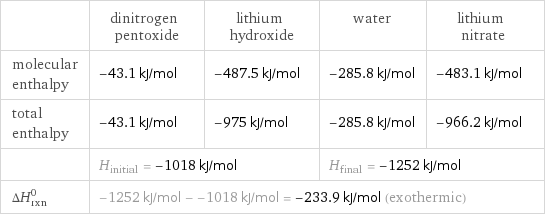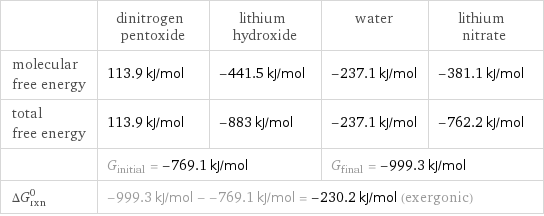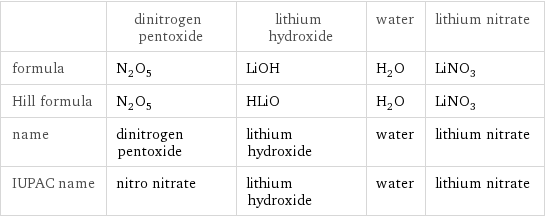Input interpretation

N_2O_5 dinitrogen pentoxide + LiOH lithium hydroxide ⟶ H_2O water + LiNO_3 lithium nitrate
Balanced equation

Balance the chemical equation algebraically: N_2O_5 + LiOH ⟶ H_2O + LiNO_3 Add stoichiometric coefficients, c_i, to the reactants and products: c_1 N_2O_5 + c_2 LiOH ⟶ c_3 H_2O + c_4 LiNO_3 Set the number of atoms in the reactants equal to the number of atoms in the products for N, O, H and Li: N: | 2 c_1 = c_4 O: | 5 c_1 + c_2 = c_3 + 3 c_4 H: | c_2 = 2 c_3 Li: | c_2 = c_4 Since the coefficients are relative quantities and underdetermined, choose a coefficient to set arbitrarily. To keep the coefficients small, the arbitrary value is ordinarily one. For instance, set c_1 = 1 and solve the system of equations for the remaining coefficients: c_1 = 1 c_2 = 2 c_3 = 1 c_4 = 2 Substitute the coefficients into the chemical reaction to obtain the balanced equation: Answer: | | N_2O_5 + 2 LiOH ⟶ H_2O + 2 LiNO_3
Structures

+ ⟶ +
Names

dinitrogen pentoxide + lithium hydroxide ⟶ water + lithium nitrate
Reaction thermodynamics
Enthalpy

| dinitrogen pentoxide | lithium hydroxide | water | lithium nitrate molecular enthalpy | -43.1 kJ/mol | -487.5 kJ/mol | -285.8 kJ/mol | -483.1 kJ/mol total enthalpy | -43.1 kJ/mol | -975 kJ/mol | -285.8 kJ/mol | -966.2 kJ/mol | H_initial = -1018 kJ/mol | | H_final = -1252 kJ/mol | ΔH_rxn^0 | -1252 kJ/mol - -1018 kJ/mol = -233.9 kJ/mol (exothermic) | | |
Gibbs free energy

| dinitrogen pentoxide | lithium hydroxide | water | lithium nitrate molecular free energy | 113.9 kJ/mol | -441.5 kJ/mol | -237.1 kJ/mol | -381.1 kJ/mol total free energy | 113.9 kJ/mol | -883 kJ/mol | -237.1 kJ/mol | -762.2 kJ/mol | G_initial = -769.1 kJ/mol | | G_final = -999.3 kJ/mol | ΔG_rxn^0 | -999.3 kJ/mol - -769.1 kJ/mol = -230.2 kJ/mol (exergonic) | | |
Equilibrium constant
![Construct the equilibrium constant, K, expression for: N_2O_5 + LiOH ⟶ H_2O + LiNO_3 Plan: • Balance the chemical equation. • Determine the stoichiometric numbers. • Assemble the activity expression for each chemical species. • Use the activity expressions to build the equilibrium constant expression. Write the balanced chemical equation: N_2O_5 + 2 LiOH ⟶ H_2O + 2 LiNO_3 Assign stoichiometric numbers, ν_i, using the stoichiometric coefficients, c_i, from the balanced chemical equation in the following manner: ν_i = -c_i for reactants and ν_i = c_i for products: chemical species | c_i | ν_i N_2O_5 | 1 | -1 LiOH | 2 | -2 H_2O | 1 | 1 LiNO_3 | 2 | 2 Assemble the activity expressions accounting for the state of matter and ν_i: chemical species | c_i | ν_i | activity expression N_2O_5 | 1 | -1 | ([N2O5])^(-1) LiOH | 2 | -2 | ([LiOH])^(-2) H_2O | 1 | 1 | [H2O] LiNO_3 | 2 | 2 | ([LiNO3])^2 The equilibrium constant symbol in the concentration basis is: K_c Mulitply the activity expressions to arrive at the K_c expression: Answer: | | K_c = ([N2O5])^(-1) ([LiOH])^(-2) [H2O] ([LiNO3])^2 = ([H2O] ([LiNO3])^2)/([N2O5] ([LiOH])^2)](../image_source/b6e609ab9d890e05c26e65a8fa97e7d7.png)
Construct the equilibrium constant, K, expression for: N_2O_5 + LiOH ⟶ H_2O + LiNO_3 Plan: • Balance the chemical equation. • Determine the stoichiometric numbers. • Assemble the activity expression for each chemical species. • Use the activity expressions to build the equilibrium constant expression. Write the balanced chemical equation: N_2O_5 + 2 LiOH ⟶ H_2O + 2 LiNO_3 Assign stoichiometric numbers, ν_i, using the stoichiometric coefficients, c_i, from the balanced chemical equation in the following manner: ν_i = -c_i for reactants and ν_i = c_i for products: chemical species | c_i | ν_i N_2O_5 | 1 | -1 LiOH | 2 | -2 H_2O | 1 | 1 LiNO_3 | 2 | 2 Assemble the activity expressions accounting for the state of matter and ν_i: chemical species | c_i | ν_i | activity expression N_2O_5 | 1 | -1 | ([N2O5])^(-1) LiOH | 2 | -2 | ([LiOH])^(-2) H_2O | 1 | 1 | [H2O] LiNO_3 | 2 | 2 | ([LiNO3])^2 The equilibrium constant symbol in the concentration basis is: K_c Mulitply the activity expressions to arrive at the K_c expression: Answer: | | K_c = ([N2O5])^(-1) ([LiOH])^(-2) [H2O] ([LiNO3])^2 = ([H2O] ([LiNO3])^2)/([N2O5] ([LiOH])^2)
Rate of reaction
![Construct the rate of reaction expression for: N_2O_5 + LiOH ⟶ H_2O + LiNO_3 Plan: • Balance the chemical equation. • Determine the stoichiometric numbers. • Assemble the rate term for each chemical species. • Write the rate of reaction expression. Write the balanced chemical equation: N_2O_5 + 2 LiOH ⟶ H_2O + 2 LiNO_3 Assign stoichiometric numbers, ν_i, using the stoichiometric coefficients, c_i, from the balanced chemical equation in the following manner: ν_i = -c_i for reactants and ν_i = c_i for products: chemical species | c_i | ν_i N_2O_5 | 1 | -1 LiOH | 2 | -2 H_2O | 1 | 1 LiNO_3 | 2 | 2 The rate term for each chemical species, B_i, is 1/ν_i(Δ[B_i])/(Δt) where [B_i] is the amount concentration and t is time: chemical species | c_i | ν_i | rate term N_2O_5 | 1 | -1 | -(Δ[N2O5])/(Δt) LiOH | 2 | -2 | -1/2 (Δ[LiOH])/(Δt) H_2O | 1 | 1 | (Δ[H2O])/(Δt) LiNO_3 | 2 | 2 | 1/2 (Δ[LiNO3])/(Δt) (for infinitesimal rate of change, replace Δ with d) Set the rate terms equal to each other to arrive at the rate expression: Answer: | | rate = -(Δ[N2O5])/(Δt) = -1/2 (Δ[LiOH])/(Δt) = (Δ[H2O])/(Δt) = 1/2 (Δ[LiNO3])/(Δt) (assuming constant volume and no accumulation of intermediates or side products)](../image_source/3f9b156ac6850b8790e978c2aca6fb7b.png)
Construct the rate of reaction expression for: N_2O_5 + LiOH ⟶ H_2O + LiNO_3 Plan: • Balance the chemical equation. • Determine the stoichiometric numbers. • Assemble the rate term for each chemical species. • Write the rate of reaction expression. Write the balanced chemical equation: N_2O_5 + 2 LiOH ⟶ H_2O + 2 LiNO_3 Assign stoichiometric numbers, ν_i, using the stoichiometric coefficients, c_i, from the balanced chemical equation in the following manner: ν_i = -c_i for reactants and ν_i = c_i for products: chemical species | c_i | ν_i N_2O_5 | 1 | -1 LiOH | 2 | -2 H_2O | 1 | 1 LiNO_3 | 2 | 2 The rate term for each chemical species, B_i, is 1/ν_i(Δ[B_i])/(Δt) where [B_i] is the amount concentration and t is time: chemical species | c_i | ν_i | rate term N_2O_5 | 1 | -1 | -(Δ[N2O5])/(Δt) LiOH | 2 | -2 | -1/2 (Δ[LiOH])/(Δt) H_2O | 1 | 1 | (Δ[H2O])/(Δt) LiNO_3 | 2 | 2 | 1/2 (Δ[LiNO3])/(Δt) (for infinitesimal rate of change, replace Δ with d) Set the rate terms equal to each other to arrive at the rate expression: Answer: | | rate = -(Δ[N2O5])/(Δt) = -1/2 (Δ[LiOH])/(Δt) = (Δ[H2O])/(Δt) = 1/2 (Δ[LiNO3])/(Δt) (assuming constant volume and no accumulation of intermediates or side products)
Chemical names and formulas

| dinitrogen pentoxide | lithium hydroxide | water | lithium nitrate formula | N_2O_5 | LiOH | H_2O | LiNO_3 Hill formula | N_2O_5 | HLiO | H_2O | LiNO_3 name | dinitrogen pentoxide | lithium hydroxide | water | lithium nitrate IUPAC name | nitro nitrate | lithium hydroxide | water | lithium nitrate
Substance properties

| dinitrogen pentoxide | lithium hydroxide | water | lithium nitrate molar mass | 108.01 g/mol | 23.95 g/mol | 18.015 g/mol | 68.94 g/mol phase | solid (at STP) | solid (at STP) | liquid (at STP) | solid (at STP) melting point | 30 °C | 462 °C | 0 °C | 264 °C boiling point | 47 °C | | 99.9839 °C | density | 2.05 g/cm^3 | 1.46 g/cm^3 | 1 g/cm^3 | surface tension | | | 0.0728 N/m | dynamic viscosity | | | 8.9×10^-4 Pa s (at 25 °C) | odor | | odorless | odorless |
Units
